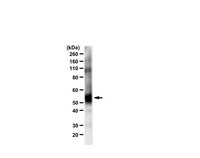ABN1647 Sigma-AldrichAnti-VGluT1
Anti-VGLUT1, Cat. No. ABN1647, is a highly specific rabbit polyclonal antibody that targets Vesicular glutamate transporter 1 and has been tested in Immunoautoradiography, Immunofluorescence, Immunohistochemistry, and Western Blotting.
More>> Anti-VGLUT1, Cat. No. ABN1647, is a highly specific rabbit polyclonal antibody that targets Vesicular glutamate transporter 1 and has been tested in Immunoautoradiography, Immunofluorescence, Immunohistochemistry, and Western Blotting. Less<<Recommended Products
Overview
| Replacement Information |
|---|
Key Spec Table
| Species Reactivity | Key Applications | Host | Format | Antibody Type |
|---|---|---|---|---|
| M, R, H | IF, IHC, Immunoautoradiography, WB | Rb | Unpurified | Polyclonal Antibody |
| References |
|---|
| Product Information | |
|---|---|
| Format | Unpurified |
| HS Code | 3002 15 90 |
| Presentation | Rabbit polyclonal antiserum with 0.05% sodium azide and 50% glycerol. |
| Quality Level | MQ100 |
| Physicochemical Information |
|---|
| Dimensions |
|---|
| Materials Information |
|---|
| Toxicological Information |
|---|
| Safety Information according to GHS |
|---|
| Safety Information |
|---|
| Packaging Information | |
|---|---|
| Material Size | 100 µL |
| Transport Information |
|---|
| Supplemental Information |
|---|
| Specifications |
|---|
| Global Trade Item Number | |
|---|---|
| Catalogue Number | GTIN |
| ABN1647 | 04054839315961 |
Documentation
Anti-VGluT1 Certificates of Analysis
| Title | Lot Number |
|---|---|
| Anti-VGluT1 | 3072819 |
| Anti-VGluT1 - 3590124 | 3590124 |
| Anti-VGluT1 - 3846467 | 3846467 |
| Anti-VGluT1 - 4005458 | 4005458 |
| Anti-VGluT1 - 4076645 | 4076645 |
| Anti-VGluT1 - 4272277 | 4272277 |
| Anti-VGluT1 Polyclonal Antibody | 3036822 |
| Anti-VGluT1 Polyclonal Antibody | Q2889120 |
| Anti-VGluT1 Polyclonal Antibody | 3094603 |
| Anti-VGluT1 Polyclonal Antibody | Q3034321 |

















